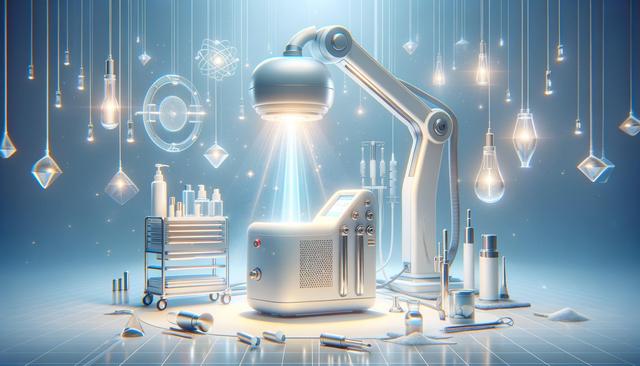Understanding CO2 Laser Skin Resurfacing
Laser skin treatments have evolved significantly over the years, with CO2 laser skin resurfacing emerging as a widely used method for addressing a range of skin imperfections. This technique uses carbon dioxide lasers to remove layers of damaged skin with precision, stimulating the production of collagen and encouraging the growth of new, healthier skin. Understanding CO2 laser skin resurfacing is essential for anyone considering this option, as it helps set realistic expectations and provides insight into how the procedure works. This method is particularly effective in targeting deep wrinkles, scars, and uneven skin tone, making it a popular choice among those looking to rejuvenate their appearance.
CO2 lasers work by delivering short pulses of high-energy light to the skin, which vaporizes the outer layers of damaged tissue. At the same time, the heat generated promotes collagen remodeling. This dual action helps improve both texture and tone over time. While the technology behind it is complex, the goal is simple: to restore a smoother, more youthful look without the need for invasive surgery.
How It Helps with Wrinkles and Fine Lines
One of the most sought-after benefits of laser skin treatment is its ability to reduce the appearance of wrinkles and fine lines. By removing the top layers of skin and promoting new cell growth, CO2 laser resurfacing can significantly soften lines, especially in areas such as the mouth, eyes, and forehead. How it helps with wrinkles and fine lines is rooted in the stimulation of collagen – a protein that gives skin its elasticity and firmness.
The treatment is especially beneficial for:
- Static wrinkles caused by aging or sun exposure
- Dynamic lines that form from facial movements
- Fine lines around the eyes and lips
Since the laser penetrates deeper layers of skin, it can provide more noticeable improvements than many topical treatments or superficial procedures. However, individual results can vary based on age, skin type, and the extent of skin damage.
What the Treatment Process Looks Like
Before undergoing laser skin treatment, it’s helpful to know what the treatment process looks like from start to finish. Typically, the procedure starts with a consultation where a professional evaluates your skin and discusses your goals. Once you’ve decided to proceed, the skin is cleansed, and a topical anesthetic may be applied to minimize discomfort.
During the procedure:
- A specialized CO2 laser device is used to target specific areas
- The laser energy removes damaged skin and stimulates new skin growth
- The session can take anywhere from 30 minutes to two hours depending on the treatment area
After the procedure, the treated skin will be red, swollen, and sensitive. This is entirely normal and part of the healing process. Your provider will give you detailed aftercare instructions to ensure optimal healing and results.
Expected Results and Recovery Timeline
Understanding the expected results and recovery timeline is crucial for anyone planning to undergo CO2 laser skin resurfacing. Immediately after treatment, you can expect redness and swelling, which gradually subside over several days to a couple of weeks. As the skin heals, it may peel and form a crust, revealing smoother skin underneath.
Typical recovery milestones include:
- Redness and swelling for the first few days
- Peeling and flaking within the first week
- Gradual fading of redness over 2–3 weeks
- Long-term improvements in skin texture and tone over 3–6 months
Final results become more apparent as your skin continues to produce new collagen. While many people notice significant improvements after one session, others may require multiple treatments for optimal outcomes. It’s important to follow your provider’s post-treatment guidelines to avoid complications and enhance results.
Choosing a Clinic and Preparing for Treatment
Choosing a clinic and preparing for treatment are important steps that contribute to the success of your laser skin resurfacing experience. Not all clinics offer the same level of expertise or technology, so it’s essential to do your research. Look for licensed professionals with experience in CO2 laser procedures, and make sure the clinic follows established safety protocols.
When preparing for your appointment:
- Avoid sun exposure and tanning for at least two weeks prior
- Discontinue certain skincare products as advised by your provider
- Discuss any medical conditions or medications you’re taking
During your consultation, ask questions about the procedure, potential side effects, and expected outcomes. A reputable clinic will provide clear information and help you determine whether you’re a good candidate for the treatment. Being informed and well-prepared can make a significant difference in both your comfort and the final results.
Conclusion
Laser skin treatment, particularly CO2 laser resurfacing, offers a valuable option for individuals looking to improve their skin’s appearance without surgery. From understanding CO2 laser skin resurfacing and how it helps with wrinkles and fine lines to knowing what the treatment process looks like and the expected results and recovery timeline, being well-informed is key. Choosing a clinic and preparing for treatment carefully ensures a smoother experience and enhances the potential for satisfying results. If you’re seeking a method to refresh your skin and address specific concerns, this type of laser treatment may be worth exploring with a qualified professional.




Leave a Reply